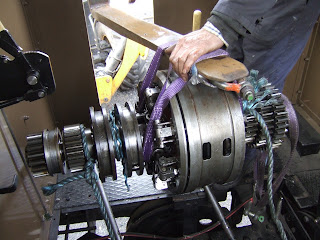Gear Assembly Removal
To remove the gear assembly it was first lifted manually using rope and steel bars sufficienty to enable two poles to be inserted underneath and raise it slightly above the casing.
After that, Queen Anne was towed outside to allow removal via the cab entrance using a forklift. Strops were used to attach the assembly as closely as possible to the tine of the forklift. The lower part of the cab entrance is too narrow for the gear assembly to pass through, but it will fit through the upper part. However it needs to be lifted to the full height of the cab.
 |
| Forklift in position |
 |
| Strops attached |
 |
| Have we got enough clearance? |
 |
| Out it comes - no problem |
The assembly was then lowered onto a sturdy trolley and wheeled to the Clean Room for dismantling.
 |
| Dismantling started |
Disassembly
A gear puller was required to remove the ball bearing and roller bearing that form the rear bearing assembly. Following that the gears can be slid off and the rear face of the clutch drum unbolted.
The next part to be removed is the clutch friction plate for Slow Gear. On removing the rear face of the clutch drum the friction material was found to have completely disintegrated. The clutch disc should have a ring of friction material on both sides, held in place by brass rivets. In fact both friction rings had deganerated into a fibrous mass. It is amazing that Slow Gear could be made to supply any drive at all.
It seems likely that the locomotive must have been run for some time in Slow Gear with the clutch slipping, causing overheating and breakdown of the friction material.
 |
| Friction plate showing the rivets which once held the friction material |
 |
| The remains of the friction material |
 |
| Clutch rubbing plate |
To engage slow gear the friction plate is squeezed between the moveable rubbing plate (pictured above) and the rear cover of the drum assembly.
A useful description of the operation of this type of gearbox can be found HERE. It contains colour-coded diagrams showing how power is transmitted in each gear. The website is run by the Moseley Railway Trust.

